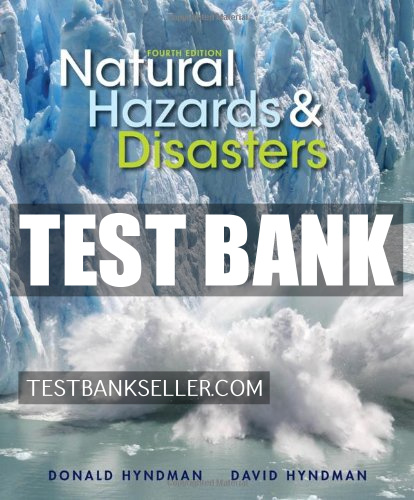The Test Bank for Natural Hazards and Disasters, 4th Edition by Donald Hyndman is designed to help students understand the key concepts of plate tectonics and the physical hazards related to earthquakes and volcanic activity. This test bank includes multiple-choice questions covering Chapter 2: Plate Tectonics and Physical Hazards, providing a solid foundation for anyone studying natural hazards.
Sample Questions:
- Question 1: In which direction is the Pacific Plate moving, based on the current chain of Hawaiian Islands, with only the easternmost island still active?
A) Northeast
B) Northwest
C) Southeast
D) Southwest
E) No movement; the chain of islands is unrelated to the active one
Answer: B - Question 2: Before the theory of plate tectonics was developed, what evidence supported the idea of continental drift?
A) Rocks on the ocean floor are oldest in the center, progressively becoming younger near the continents.
B) Rocks on continents can be traced through the ocean floor to the other side.
C) Evidence of human carvings found in Africa that resemble those in Brazil.
D) Glaciers near the Amazon River carried unique rocks into South Africa, showing the two continents were once connected.
E) Bedrock formations on both sides of the Atlantic matched in age.
Answer: E - Question 3: Which piece of evidence was NOT used to support the idea of continental drift?
A) Matching bedrock formations across the Atlantic
B) Matching coastlines along the Atlantic
C) Similarities in rock formations across the Atlantic
D) Matching ages of continental rocks across the Atlantic
E) The shift of magnetic poles from north to south
Answer: E - Question 4: Which of the following is accurate?
A) The mantle is denser than the lithosphere.
B) The lithosphere is denser than the mantle.
C) The asthenosphere is the rigid part of the mantle.
D) The asthenosphere is the more pliable part of the mantle.
E) The mantle is generally stiffer than the crust.
Answer: D - Question 5: Which of the following is true?
A) Oceanic rift zones are found exclusively in the center of oceans.
B) Rift zones are only found in ocean basins.
C) Rift zones are regions where oceanic crust is created.
D) Rift zones are the oldest sections of oceanic crust.
E) Rift zones represent the boundary between oceanic crust and continental crust.
Answer: C - Question 6: Which statement is NOT true?
A) Subduction zones are where oceanic floor sinks into the mantle.
B) Subduction zones are areas of major earthquake activity.
C) Subduction zones are linked to the formation of active volcanoes.
D) Subduction zones are areas where ocean floor rocks are created.
E) Subduction zones are marked by the deepest ocean parts.
Answer: D - Question 7: Which of the following is accurate?
A) Transform faults primarily involve vertical movement.
B) Transform faults are only found in ocean basins.
C) Transform faults involve spreading and the generation of new crust.
D) Transform faults gradually change from horizontal to vertical motion over time.
E) The movement along transform faults typically stops suddenly at both ends.
Answer: E - Question 8: What does the oceanic lithosphere consist of?
A) Basalt overlying peridotite
B) Only basalt
C) Only peridotite
D) Basalt and peridotite in alternating layers of varying thickness
E) A mixture of basalt and granite
Answer: A - Question 9: Earthquakes are most commonly associated with which type of lithospheric plate boundaries?
A) Only convergent (subduction zones)
B) Only divergent (spreading zones)
C) Only transform
D) Only divergent and transform
E) Convergent, divergent, and transform
Answer: E - Question 10: Where are andesite stratovolcanoes most commonly located?
A) Rift zones on continents
B) Collision zones between continental plates
C) Subduction zones between oceanic and continental plates
D) Subduction zones between two continents
E) Transform fault boundaries between oceanic and continental plates.
Answer: C
Key Features:
- Detailed focus on plate tectonics and related physical hazards such as earthquakes and volcanic activity.
- This test bank includes multiple-choice questions to evaluate understanding of essential concepts.
- Instant download with no waiting time.
- Ideal for students studying geology, earth sciences, and natural disasters.
This test bank is a useful resource for reinforcing your understanding of natural hazards and the role of plate tectonics in shaping Earth’s physical landscape. It is designed to support exam preparation and provide comprehensive insight into geological processes.












Reviews
There are no reviews yet.